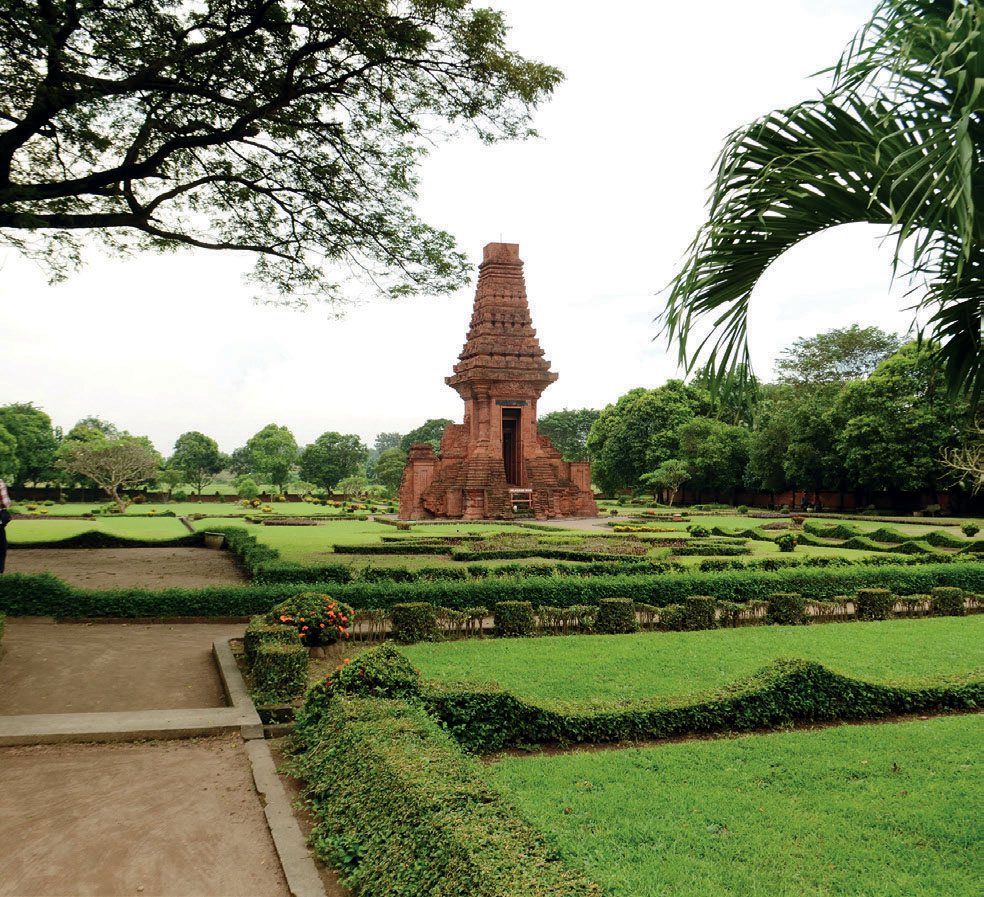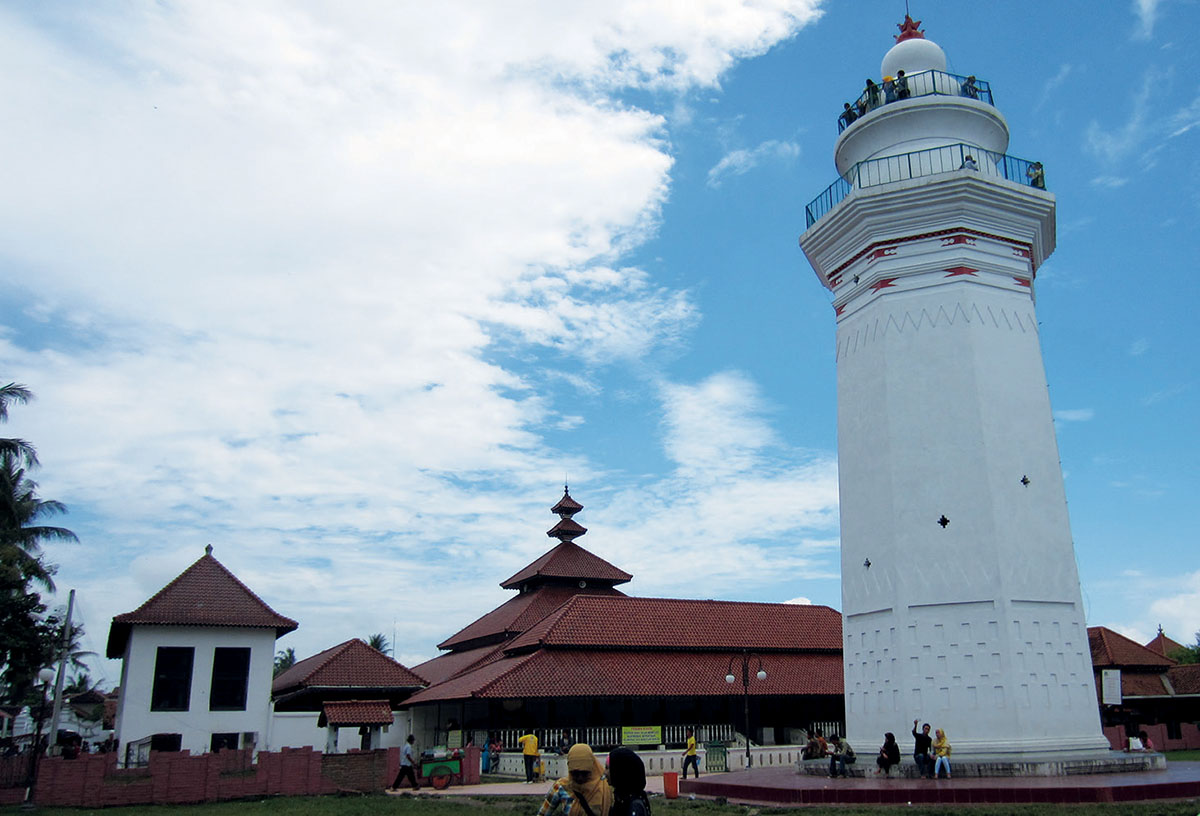Heritage and political change in Indonesia
Adrian Perkasa, my friend and colleague from Airlangga University, drove a circuitous route, avoiding trucks, chickens and rice drying on the road, on our way to the shrine known locally as Watu Ombo. As occurred at all of the small shrines near villages, the Caretaker (Juru Pelihara) appeared a few minutes after we arrived to see what we were doing and chat about the place his family had looked after for three generations. It was the day after the monthly special day on the Javanese calendar (Malam Jumat Legi) when many Javanese people visit shrines, and the offerings from the night before were evident. The Caretaker had also gathered a set of fourteenth century foundation stones from the Majapahit kingdom, excavated by traditional brick makers, that he was keeping on site. There were large trees within the shrine’s compound and other residents were sitting around chatting or keeping an eye on their rice drying in the parking lot.
The management and spatial organisation of Watu Ombo differs considerably from the larger sites that were reconstructed in the 1980s and 1990s. These iconic sites are the product of large state investments fuelled by the success of Borobudur, the nationalist importance of the Majapahit as the precursor of the Indonesian nation, and the growth of oil prices. Take, for instance, Bajang Ratu (fig.1). The structure, an entrance gate to a compound, is located in the middle of a European style garden with little shade. While indeed monumental and impressive, the lack of shade, seating and other activities in the surrounding park lessens the utility of the site for residents, and visitors tend to stay for short periods where they enter the park, take pictures of the gate, walk briefly around the garden before returning to their car or bus, and heading to the similarly organised Candi Tikus. Paid staff maintain the site during opening hours, and it is locked at night. Until the mid-1990s, this site was like Watu Ombo before graves and homes were relocated to make way for the park.
While my comparison highlights the richness of Indonesians’ relationships with heritage and how they exist in tension with official management practices, there is no simple binary between expert and community sites and practices. Local people worked for years on the reconstruction of ‘official’ sites, becoming experts in such conservation work, not to mention the strong feelings that remain for these sites amongst residents. The state pays locals to maintain the ‘community’ sites and has done so since colonial times; local people work as gardeners and officials at the larger sites to service the busloads of visitors who stop for half an hour on their day trips to Trowulan. Furthermore, democratic Indonesia has an uneven heritage politics, where the shifts at higher levels (such as decisions at the national level or international funding) can have different implications and effects at the level of site management for different groups and in different locations. Below, I turn my attention to the drivers and complications of heritage politics in Indonesia, using examples drawn from contributors to a special issue on Indonesian heritage in Inside Indonesia, which I co-edited with Riwanto Tirtosudarmo earlier this year. 1
Decentralising culture
The Suharto era command culture model of cultural management, while challenged by the rise of mass popular culture in the 1990s, began to break down in the aftermath of the Asian Financial Crisis and the resignation of Suharto in 1998.2 Two shifts in particular were important. First, cultural policy was realigned from an affiliation with education to an affiliation with tourism.3 Second and more importantly, cultural policy was one of a number of policy areas decentralised in 2002, devolving control of the cultural bureaucracy from the national to the provincial and district levels. While thousands of staff shifted from the national bureaucracy to the provincial and district bureaucracies, this did not include archaeological offices (Balai Pelestarian Cagar Budaya and the Balai Konservasi Borobudur) that remain centrally controlled from the Directorate of Culture and continue to manage archaeological sites. From an educational function, culture was aligned with the economic goals of tourism and regional development. District and provincial governments became more important to heritage planning and management, but have differing levels of commitment and capabilities. Furthermore, heritage legislation reform, which passed parliament in 2010, has stalled due to the absence of implementing legislation, leaving heritage management frameworks weak and uncertain.
Banten Lama in particular has struggled to find a balance between different interests in the contemporary period.4 Banten Lama was home to an Islamic sultanate in the sixteenth century that became an important religious centre for the spread of Islam across Java, and its Grand Mosque (Masjid Agung) is now the centrepiece of a diverse heritage precinct that attracts thousands of visitors annually (fig. 2). However, divisions within the leadership of Masjid Agung has led to uncertain decision making, from conservation work on the mosque to the location of the mosque entry gates and the stalls of petty traders. This division makes site planning and management difficult for Banten City. The last local regulations, passed in 1990, are not adequate for the number of visitors and complexity of the site. The uncertain heritage regulatory framework contributes to paralysis and bureaucratic unwillingness to work within a difficult situation, even when these issues are undermining both the experiences of visitors and the returns for locals.
Heritage in broader processes of spatial change
Considerations of heritage should take into account the effects of broader processes of spatial change. Trowulan, the previously mentioned location of the capital of the Majapahit kingdom, is located within an hour’s drive from Surabaya on a major road. Although the population of Trowulan is just under 70,000, it is part of Gerbangkertosusila—the mega-region of ‘Gresik Bangkalan Mojokerto Surabaya Sidoarjo Lamongan’ that had a population of 9 million people in 2010. While Trowulan’s red bricks have clearly been manufactured for hundreds of years, the urbanisation of this region has created an unprecedented demand for building materials. The remains of the Majapahit capital inhabit an area of approximately 90 square kilometres under contemporary structures and sugar cane fields. Traditional red brick construction removes the top one to two metres of top soil from a field that is rented from a farmer, making the traditional red brick manufacturers the most active excavators of Majapahit era artefacts. While this is near-impossible to prevent (even as part of a national heritage listing in 2013), my research with Adrian Perkasa indicates that the red brick manufacturers have relationships with Majapahit heritage and value the artefacts they find. The potential is there for engagement and interaction around their excavations to build new relationships between residents, researchers and Trowulan’s underground capital.
Changing heritage management practices
The political climate in democratic Indonesia also has offered opportunities for civil society groups to push new heritage agendas. The Indonesian National Trust (Badan Pelestarian Pusaka Indonesia—BPPI) formed in 2004 from a network of city-based groups and individuals across Indonesia. Protests and actions by these groups, the World Monuments Fund, and the Save Trowulan resident group, prevented a steel factory that had been approved in 2013 by the archaeological bureau from being built in an area close to residential areas.5 Changes within archaeology towards site management led in the early 2010s to a greater willingness to accommodate access to previously closed archaeological areas, in particular the smaller, less-visited sites.6 This new access has driven both local activities, such as guiding tourists and local events, as well as new online groups, like Bol Brutu who use Facebook and WhatsApp to share photographs and news, to organise short and long trips for visiting heritage places, as well as other activities like exhibitions and recording local histories. However, these lower level activities still run into the issue of official heritage management. At the larger, more regulated heritage sites, local guides who are not officially registered cannot seek customers, and Bol Brutu cannot undertake their creative activities.
The entry of democratic politics has been beneficial to the cultural ecology of Indonesia and has enabled new coproductions of heritage through a more open approach to site management and more incentives for collaborations across different groups and levels of government. However, state heritage management could do more to support the cultural ecology, in particular through finalising the heritage legislation, encouraging further engagement with public archaeology in state archaeological institutions, and allowing even greater access to residents who want to seek inspiration and opportunities from access to state-managed heritage sites and objects. Denis Byrne has pointed out to us that most of the population of Asia seeks special connections and favours from their relationships to heritage objects and sites.7 There are openings in Indonesia for heritage management to be relevant to the vast numbers of people who hold this understanding.
Tod Jones (T.Jones@curtin.edu.au) is a Senior Lecturer in Geography at Curtin University in Perth, Australia. His research interests are in Human Geography with a focus on heritage, cultural economics and cultural policy in Indonesia and Australia. His book, Culture, Power and Authoritarianism in the Indonesian State: Cultural Policy across the Twentieth Century to the Reform Era was published by Brill in 2013. Tod recently coedited an edition of Inside Indonesia with Riwanto Tirtosudarmo on contemporary heritage issues in Indonesia (www.insideindonesia.org/edition-123-jan-mar-2016).

